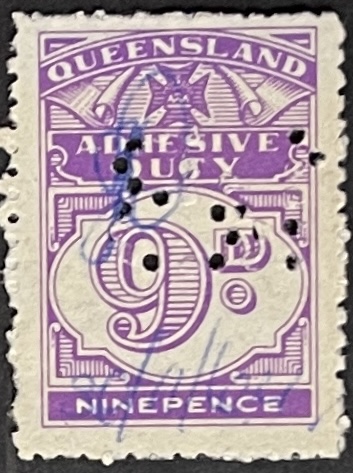| |
Private Revenue Perfins of Queensland An Elsmore Coath production The authors would welcome your comments additions or input into this work A B C E F G H I K L M N O P Q R S T V W Other M -------------------------------------------------------- M&B.a User: A D Meares and Bishop Stockbrokers
Address: 33 Bligh St, Sydney, NSW Revenue Use: Numeral 1938-66 issue
9d, 1/-, 2/-, 5/- Rarity Scale: Numeral 1938-66 issue 9d R3, 1/- R3, 2/- R3, 5/- R4 Background: Alfred Meares was born in Sydney in November 1904 and in 1926 he became a clerk at the Sydney Stock Exchange. In 1932 he took a seat at the Sydney Exchange and worked for a small group of private clients. After an absence for military service in World War 2 he returned to his seat and in 1949 he went into partnership with Jesse Bishop as A D Meares and Bishop. Jesse Bishop had been born in Sydney in 1907 and was educated at Sydney University but completed his studies at Cambridge in England. Graduating in 1934 he worked for the Imperial Smelting Corporation for a short period before gaining a position with the stockbroking firm W Thompson and Son. and later Dormer Rumball and Co. in which he secured a partnership and a seat on the London Stock Exchange in 1940. As with his future partner his career was punctuated by the war. After the war he worked in the legal department at Shell before returning to Australia for family reasons in 1948. In 1949 he joined the Sydney Stock
Exchange as a sole trader but soon joined fellow
sole trader Meares. Bishop remained with the firm until
1965 and Meares retired from his role in the firm in
1970. Multiples of this pattern show an
inconsistent relationship to each other so the
device is most likely a single head one. This is
supported by the fact that the strikes are identical
which is less likely on a multiple die device, which
often show variation between dies. The M&B device is only found on
revenue stamps and the use on documents shows that
the stamps are punctured prior to being affixed,
indicating use as a security device rather than a
cancelling device. The use as a security device to
prevent theft is further supported by the fact that
once affixed the stamps are then cancelled either by
pen, company cachet or circular punch. The device was used between 1962
and 1967. Related Patterns: Refer to other
usage of this A D Meares and Bishop device in: -------------------------------------------------------- A B C E F G H I K L M N O P Q R S T V W Other © copyright 2011 |

